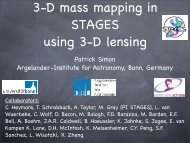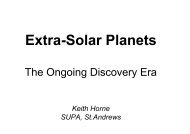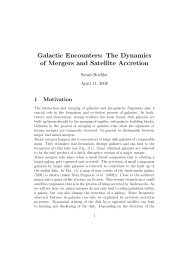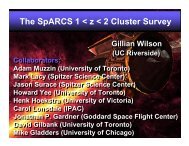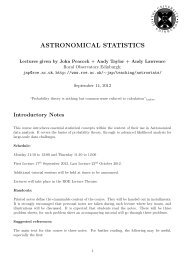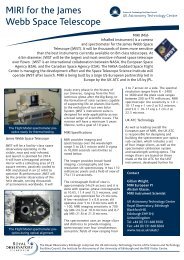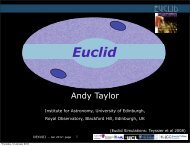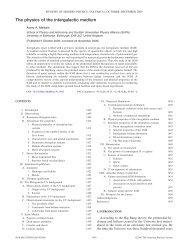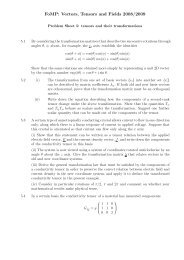Physical Characterisation of the Binary EKBO 2001 QT297
Physical Characterisation of the Binary EKBO 2001 QT297
Physical Characterisation of the Binary EKBO 2001 QT297
You also want an ePaper? Increase the reach of your titles
YUMPU automatically turns print PDFs into web optimized ePapers that Google loves.
Draft<br />
Figure 2. Differential photometry plot from <strong>the</strong> night <strong>of</strong> UT 2002 July 18. The upper panel<br />
shows <strong>the</strong> magnitude difference between a comparison star and <strong>the</strong> <strong>2001</strong> QT_297 primary, <strong>the</strong><br />
center panel plots <strong>the</strong> difference between <strong>the</strong> star and <strong>the</strong> secondary component, and <strong>the</strong> lower<br />
panel plots <strong>the</strong> difference between <strong>the</strong> comparison star and a check star.<br />
The variability data for <strong>the</strong> UT 18 July 2002 observations suggests a possible single peak<br />
lightcurve <strong>of</strong> about 0.6 magnitude (peak to peak) amplitude with a period between 4.5 and 5<br />
hours or a dual peaked lightcurve with twice that period. Since all evidence for variability can be<br />
attributed directly to <strong>the</strong> secondary component, we are able to use our complete data set <strong>of</strong><br />
differential magnitude observations between <strong>the</strong> primary and secondary to determine a precise<br />
rotational period for this body. The advantage here is that <strong>the</strong> long time interval from October<br />
<strong>2001</strong> to July 2002 gives excellent leverage to <strong>the</strong> lightcurve phasing (i.e. with over 1200 rotations<br />
over <strong>the</strong> interval, a 3 second change in period will result in a one hour shift in phase). By first<br />
exploring phase dispersion minimization analysis <strong>of</strong> <strong>the</strong> entire data set and subsets on UT 13 and<br />
18 July 2002, we were able to reduce <strong>the</strong> number <strong>of</strong> possible periodicities to explore. Additional<br />
explicit phasing <strong>of</strong> <strong>the</strong> entire data set was used to explore consistency between nights with<br />
recognizable slopes and turn-around points and to discriminate periodicities with contradictory<br />
data.



